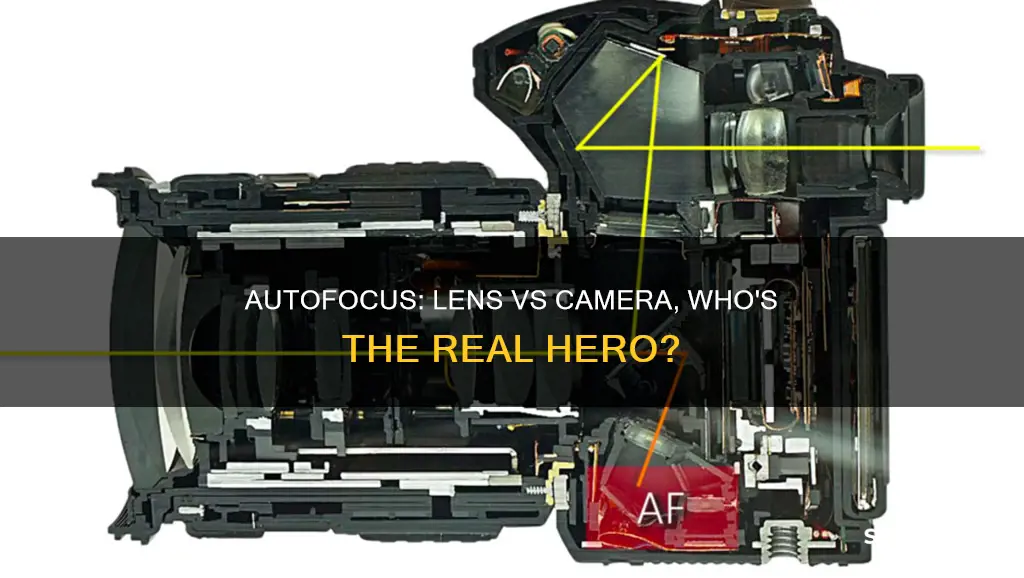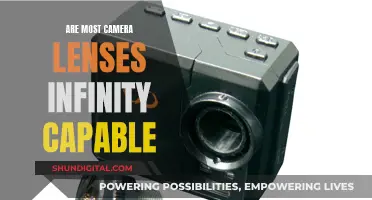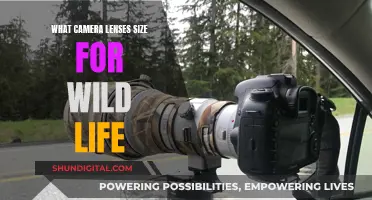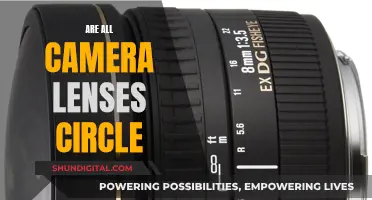
Autofocus is a feature on most cameras that automatically focuses on the subject of a photo. The autofocus system can be split into two types: active and passive. Active AF systems use the camera to emit a signal (such as an ultrasonic or infrared signal) toward the subject, which is then reflected back to the camera's focus sensor. The time it takes for the signal to return is used to calculate the distance of the subject and adjust the lens focus accordingly. Passive AF systems, on the other hand, use sensors to analyse the image coming through the lens, detecting the contrast or phase to determine the correct focus. Passive AF is the more common system today, found on DSLR and mirrorless cameras, and offers a greater number of autofocus points than active AF.
| Characteristics | Values |
|---|---|
| Autofocus system | Active AF, Passive AF |
| Passive AF system | Phase detection, Contrast detection |
| Active AF system | Ultrasonic sound waves, Infrared light |
| Autofocus sensors | Cross-type sensors, Vertical line sensors |
| Autofocus modes | Single shot, Continuous focus |

Active vs Passive AF
There are two types of autofocus (AF) systems: Active and Passive. The Active AF system works by projecting a red beam onto the subject, which then bounces back to the camera, allowing it to calculate the distance between the camera and the subject. The camera then uses this information to adjust the focus of the lens. Active AF is useful in low-light environments where normal (passive) AF does not function. However, it is limited to stationary subjects and only works for close-up shots.
On the other hand, the Passive AF system works very differently. Instead of relying on a red beam, it uses either "Phase Detection" or "Contrast Detection" (or a combination of both) to detect contrast. Phase Detection AF uses an array of microlenses to split light into a pair of images and measure the distance between them. This information is then used to adjust the lens focus. Contrast Detection AF, on the other hand, relies on software algorithms to scan for edge detail and adjust focus accordingly. It is generally slower but more reliable in low-light conditions.
Most modern DSLR and mirrorless cameras use a combination of Phase and Contrast Detection AF, known as Hybrid AF, to achieve fast and accurate results.
Advantages and Disadvantages
Active AF is useful in situations where there is insufficient light for Passive AF to function. However, it has several limitations. It can only be used for stationary subjects and only works for close-up shots. It also cannot focus through windows or other transparent objects, and its accuracy is often lower than that of Passive AF.
Passive AF, on the other hand, does not have the same limitations as Active AF. It can focus through windows and works with moving subjects. However, it relies on the presence of areas of high contrast, and may struggle in low-light conditions or when there is low contrast in the scene.
Both Active and Passive AF systems have their advantages and disadvantages. The choice between the two depends on the specific requirements of the photographer and the shooting conditions. Most modern cameras use a combination of both systems, known as Hybrid AF, to achieve fast and accurate autofocus performance.
Camera Lens Cleaning: To DIY or to Outsource?
You may want to see also

Phase Detection
The autofocus sensor compares the two distinct images, evaluating their positional relationship. A computer inside the camera then instructs the lens to adjust its focusing elements until the two images appear identical, achieving perfect focus.
In contrast to phase detection, mirrorless cameras, point-and-shoot cameras, and DSLR cameras in live view mode tend to use contrast detection autofocus. This method uses the light falling on the main sensor to achieve focus and provides an almost unlimited number of autofocus points. However, it is slower as the camera must constantly evaluate images to achieve focus.
Repair Rates for Camera Lenses: What You Need to Know
You may want to see also

Contrast Detection
However, contrast detection has the advantage of allowing for an almost unlimited number of focus points. Cameras with touchscreens can focus on any point designated by the user.
Unlocking the Power of Macro Camera Lenses
You may want to see also

Autofocus Sensors
Autofocus (AF) systems use a combination of sensors, a control system, and a motor to focus on a selected point or area. The data collected from these sensors is then used to control an electromechanical system that adjusts the focus of the optical system.
There are two main types of autofocus sensors: passive and active. Passive AF systems, including contrast detection and phase detection, rely on analysing the image entering the optical system without directing energy like ultrasonic sound or infrared light towards the subject. Contrast detection measures the contrast within a sensor field through the lens, adjusting the optical system until maximal contrast is detected. Phase detection, on the other hand, divides the incoming light into pairs of images and compares them to calculate the required amount of focus-ring movement.
Active AF systems, on the other hand, measure the distance to the subject independently of the optical system and then adjust the focus accordingly. This can be done through various methods, including ultrasonic sound waves and infrared light.
Most modern SLR cameras use through-the-lens optical sensors, which offer increased speed and precision compared to manual focus with an ordinary viewfinder. Additionally, some modern cameras feature rectangular sensors that provide two-dimensional intensity patterns for more detailed analysis.
The autofocusing process typically involves an autofocus processor (AFP) making small changes in the focusing distance, reading the AF sensor to assess improvements, and then setting the lens to a new focusing distance. This process is repeated until satisfactory focus is achieved, usually within a fraction of a second.
The number and type of autofocus points vary across camera models, with high-end SLR cameras offering 45 or more autofocus points, while others may have as few as one central AF point. The accuracy of autofocus is influenced by factors such as light levels, subject contrast, and camera or subject motion.
Overall, autofocus sensors play a crucial role in ensuring sharp and focused photographs by utilizing various technologies to measure and adjust the focus based on the image's contrast and other factors.
Mastering the Art of F-Stops in Camera Lenses
You may want to see also

Focus Lock
There are two types of focus lock: locking focus for a single shot and locking focus for multiple shots.
Locking Focus for a Single Shot
This is the most common use of focus lock and is useful when you want to take a single photo with an off-centre subject. To use it, point your camera at the subject and half-press the shutter button. You should hear a beep and see a light come on in the viewfinder to let you know the camera has focused. The focus will now remain locked while your finger is still holding the shutter button half down. With the focus locked, you can now recompose your shot before taking the final photo.
Locking Focus for Multiple Shots
If you want to take several photos all with the same focus distance, normal focus lock won't work because it doesn't "remember" its settings between photos. However, if you own a digital SLR there's a simple trick you can use to keep your focus constant for as long as you'd like.
Start by focusing your scene using your camera's autofocus as normal. Once you're happy, flick your lens into manual focus mode (most lenses have a switch on the side). This disables the autofocus feature and keeps the focus distance fixed where it is, ensuring that all shots are focused the same. When you're done, simply switch back to autofocus mode. This only works when the subject is always at a constant distance from the camera, such as in still life or landscape photography.
When to Use Focus Lock
Cleaning Camera Lenses and Filters: A Step-by-Step Guide
You may want to see also
Frequently asked questions
Autofocus is a system that takes the pressure off when you want a perfectly focused photo. With this software, your camera does all the work to figure out how to focus on the subject in your frame. The lens scans the scene and automatically identifies the subject on which to focus.
Autofocus lenses have two types of systems: active and passive. Passive is the standard and most efficient type of lens software, and it is used in DSLR and smartphone cameras. Using phase or contrast detection, the software uses mirrors or algorithms to compare a set of images and determine where they match up. This method tells the camera where to move the focusing ring, so you get a consistently clear photograph.
With the active system, the lens shoots a beam of red light at the subject which bounces back to the camera to inform the device of the object's distance from the lens. The camera uses this information to adjust the lens and focus the image. This method is useful in dimly lit environments where standard (passive) autofocus is not working. A downside to active AF lenses is that you can only use them for stationary photography.
Phase detection tends to be better at tracking fast-moving subjects because the system works quicker. With phase detection, light bounces off mirrors that quickly adjust to keep the image in focus. Still, contrast detection uses algorithms that probe for edge detail, which can take longer in some cameras. It works best for high-contrast photos, in which the algorithm scans the pixels in the camera's sensor.
With manual lenses, you must guess or measure the distance between you and your subject to make sure you're using the right lens and adjusting the focus correctly. If someone moves, you might have to start all over again. Autofocus lenses give you more freedom to move around or allow your subject to move around without constantly messing with the lens.







